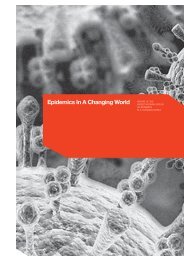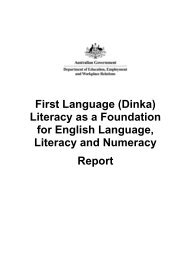National Survey of Research Commercialisation - Australian ...
National Survey of Research Commercialisation - Australian ...
National Survey of Research Commercialisation - Australian ...
Create successful ePaper yourself
Turn your PDF publications into a flip-book with our unique Google optimized e-Paper software.
XENOME<br />
The same chemical compounds that enable some animals to stun and capture prey may<br />
provide human medicine with a new source <strong>of</strong> pain-killing drugs.<br />
<strong>Research</strong>ers at Xenome Ltd have completed successful animal trials <strong>of</strong> a new pain-killing<br />
compound derived from the venom <strong>of</strong> cone shells, common to many reef environments.<br />
The animals, members <strong>of</strong> the Conidae family <strong>of</strong> molluscs, prey on other marine<br />
organisms, immobilising them with unique venoms.<br />
In January 2000, the promising results <strong>of</strong> seven years’ research conducted at the<br />
University <strong>of</strong> Queensland led to the formation <strong>of</strong> Xenome Ltd to begin commercialising<br />
new pain-killers and sedatives for humans.<br />
The research has concentrated on the components <strong>of</strong> the venom conotoxins that act by<br />
preventing neuronal communication.<br />
The cone shell research was initiated by the Venoms <strong>Research</strong> Group at the University <strong>of</strong><br />
Queensland in 1993, lead by Dr Richard Lewis and Pr<strong>of</strong>essor Paul Alewood. The team<br />
found that while the venom as a whole was potentially fatal, individual molecules within<br />
the venom had unique and potentially beneficial effects.<br />
It was found that these molecules were able to bind with receptors in the nervous system<br />
in a similar manner to drugs like morphine, but without the same side-effects such as<br />
nausea and addiction. This became the basis for further investigating the potential use <strong>of</strong><br />
these natural compounds as new therapeutics.<br />
Initial funding was supplied by the ARC and NHMRC to the Venoms <strong>Research</strong> Group<br />
and subsequently via an R&D Start Grant to Xenome Ltd <strong>of</strong> $1.75 million.<br />
The ongoing commercialisation <strong>of</strong> the science at Xenome has also been supported by<br />
Medical Holdings Limited, a pooled development fund which has invested $3 million in<br />
the venture, plus $3.5 million from another specialist investment fund, BioTech Capital.<br />
The compound that has been developed has been tipped to be the leader in a new class <strong>of</strong><br />
pain-killing drugs for the treatment <strong>of</strong> chronic pain conditions.<br />
Xenome’s Operations Manager, Joanne Schrauwen, also said that while cone shells had<br />
been the initial focus <strong>of</strong> the research, work was now progressing to investigating the<br />
venom <strong>of</strong> other animals such as spiders.

















